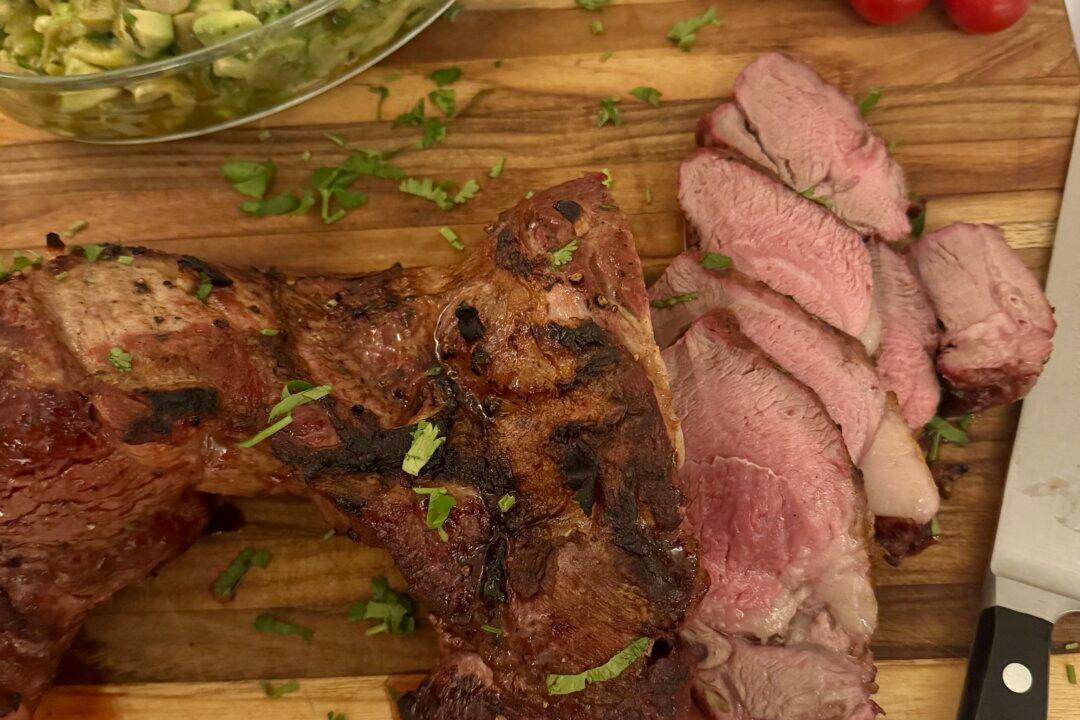Aromatic fresh basil motivates dinner many a night all year long—shredded over pasta, pureed into vegetable soups, torn on a steak sandwich, chopped in fish salad, and raw in tomato salads. I never get enough. We grow so much basil in the garden that I can use it like lettuce. Never mind the containers of pesto stocked in the freezer.
When the weather turns too cool for container basil, I seek out basil varieties at produce stores and Asian markets. Sweet Genovese basil pairs perfectly with Italian and Mediterranean dishes. Purple basils are great as a garnish and in salads.
Thai basil is well-suited to Asian-inspired meals and stir-fries. Holy basil, used frequently in Thai cooking, has slightly larger leaves and a more pronounced peppery flavor than Thai basil. Try it when it’s available.
I use basil varieties interchangeably. Nearly all varieties of basil provide that anise, peppery, minty jolt I so enjoy in my cooking.
I love the pairing of basil with fall green beans found at farmers markets for a few more weeks. These distinctive green flavors work so well together. Thai basil in particular with its strong licorice flavor complements the simple vegetable. Add in garlic and a little hot chile for an unforgettable stir-fry. Thin slices of pork tenderloin make the combination a main dish.
To season the green beans, pork, and basil, combine fish sauce with soy and oyster sauces. Fish sauce, made from fermented fish and salt, adds a savory, umami flavor found in much of Southeast Asian cooking. Look for it in the Asian section of large supermarkets or order online and select the brand with the fewest number of ingredients, such as Red Boat. I like to use reduced-sodium soy sauce here to accommodate the salty, robust flavors of fish sauce and oyster sauce.
Organization is crucial for any stir-fry. Cook the rice and prepare all the ingredients before heating the well-seasoned wok or skillet over high heat. The more heat, the more flavor.
Pork Tenderloin and Green Bean Stir-Fry With Basil
Serves 4 to 5- 1 large pork tenderloin, 1 to 1 1/4 pounds
- 4 tablespoons reduced-sodium soy sauce
- 1 to 1 1/2 pounds skinny green beans, ends trimmed
- 2 cups jasmine rice or long-grain white or brown rice
- 2 teaspoons cornstarch
- 1/2 cup reduced-sodium chicken broth or water
- 3 tablespoons fish sauce
- 2 tablespoons oyster sauce or Worcestershire sauce
- 2 tablespoons agave syrup or sugar
- 4 green onions, trimmed, or 2 large shallots, finely chopped
- 4 cloves garlic, finely chopped
- 1 small hot chile pepper, stemmed, seeded, finely chopped (or 1/2 teaspoon crushed red pepper flakes)
- 1 1/2 to 2 cups fresh Thai basil leaves (or a combination of fresh sweet basil, baby arugula, and fresh mint leaves)
- 1/4 cup expeller pressed canola oil, safflower, or sunflower oil
Heat a large pot of salted water to boil. Add green beans and cook uncovered until crisp-tender, about 5 minutes. Drain well; rinse under cold water to stop the cooking. Set aside. (Beans can be cooked up to two days in advance; refrigerate covered.)
Cook rice in a rice cooker or on the stovetop according to package directions.
Meanwhile, dissolve cornstarch in broth in a small bowl. Stir in the remaining 3 tablespoons soy sauce, the fish sauce, the oyster sauce, and the agave syrup. Set sauce near cooking surface. Have onions, garlic, chile pepper, basil, and oil near the cooking surface.
Heat a large well-seasoned wok or deep nonstick skillet over medium-high heat until a drop of water sizzles on contact. Add 2 tablespoons of the oil and the onions, garlic, chile pepper, and half of the pork. Increase heat to high and stir-fry until pork is golden, 2 or 3 minutes. Remove with a slotted spoon to a plate.
Add the remaining 2 tablespoons oil to the wok. Add the remaining pork to the pan. Stir-fry until pork is golden, 2 to 3 minutes. Stir in green beans, reserved cooked pork with all the juices on the plate, and the sauce. Stir-fry until thickened slightly, about 2 minutes. Stir in the basil. Remove from heat.
Serve accompanied by hot rice.







